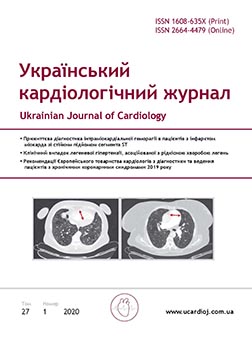Coagulation properties of the blood coagulation system in acute pulmonary embolism and their dynamics against the background of systemic thrombolytic therapy for patients with different risk of hospital mortality
Main Article Content
Abstract
The aim – to evaluate the dynamics of blood coagulation changes in patients with acute pulmonary embolism before and after systemic thrombolytic therapy (TLT), by comparing high and intermediate-high risk groups.
Materials and methods. 45 patients, 29 male (62 %) and 17 female (38 %), 55.6±13.6 years old admitted into an intensive care unit with the first episode of acute PE and received systemic thrombolysis, were included into prospective nonrandomized investigation. Accoding to the ESC Guideline on pulmonary embolism (2014) these patients were split into two groups: unstable high-risk pulmonary embolism patients having or hypotension or episodes of syncope (group 1, n=28, 62 %), and patients with intermediate-high mortality risk with stable hemodynamic indexes (group 2, n=17, 38 %) but with massive bilateral embolism (U1-2=2.2, p=0.33), verified by multispiral computed tomography pulmonary angiography (angio-regimen), hemodynamically overload, with signs of right and ventricular dysfunction and positive troponin tests. The 30-day mortality risk for PESI corresponds to Grade V (IV): 152 ± 19 points in group 1, 138.0±9.7 in group 2 (p1-2<0.01).
Results and discussion. In both groups, a similar (p1-2>0.25) initial procoagulant status was revealed by changes in thrombin formation indexes: prothrombin time (PT) increased to 19.8 [16, 23] sec, and prothrombin index increased to 96.1 % [86, 106], reduction of activated partial thromboplastin time to 23.5 [21, 24] sec. The content of the main coagulation substrate fibrinogen increased up to 4.3 [4.1, 4.5] g/l (p1-2=0.25), and markers of thrombinemia increased as follows: soluble fibrin up to 17.0 [16, 18] mg, D-dimer up to 5214 [3605, 5643] ng/ml. The systemic fibrinolytic activity was initially suppressed: the values of spontaneous fibrinolysis were reduced to 9.5 [6.0, 12.2] %, self-retraction – to 31.9 [26.1, 36.1] %. On the 5th day after the TLT on the background of basic therapy, the following dynamics was observed: increase of (Z=5.62, p<0.00001) activated partial thromboplastin time values – up to 46.1 ± 6.0 s (p1-2=0.36) and PT – up to 22.9 (18–26) s, while fibrinogen decreased – down to 3.5 g/l. Despite favorable changes, markers of thrombinemia remained increased: although fibrin values decreased (Z=3.03, p<0.001) to 13.7 mg, but still exceeded the upper limit of the reference range in both groups (p1-2=0.21). The values of spontaneous fibrinolysis increased to 11.9 % [9.9, 12.4], and self-retraction (Z=0.64, p<0.01) to 32.0 % [27.9, 33.0], remaining significantly lower than the reference level and indicating high risk of relapse of thromboembolic events.
Conclusions. For patients with acute pulmonary embolism, regardless of the presence of high or intermediate-high risk, according to the main coagulation indexes, the procoagulant state of hemostasis, inhibition of fibrinolytic activity, decrease in clot density in vitro are identical in strength and direction. On the 5th day after TLT on the basic anticoagulation therapy and despite a certain level of therapeutic anticoagulation, a rather high level of markers of thrombinemia, inhibition of fibrinolysis and retraction persists. The presence of the same coagulation changes in strength and orientation, the depletion of fibrinolytic mechanisms of hemostasis, the positive clinical impact of TLT in the intermediate-high risk group supports indications for TLT in this group of patients.

